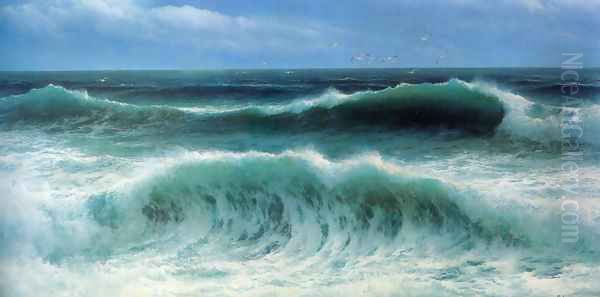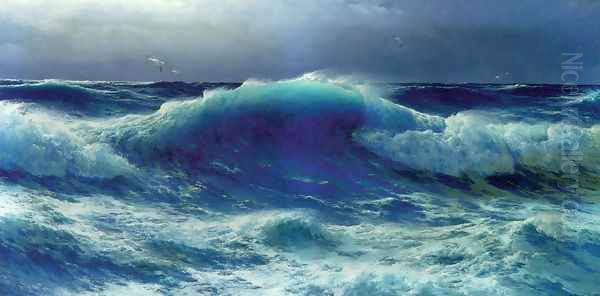
David James stands as a notable figure in late 19th-century British art, primarily celebrated for his dedication to marine painting. Active during a period of significant artistic evolution, James carved a niche for himself through his realistic and often dramatic depictions of the ocean in its various moods. Though details of his personal life remain somewhat scarce, his body of work provides a clear window into his artistic focus and technical skill.
Origins and Early Career
Born in 1853, David James entered the British art scene during the latter half of the Victorian era. Information regarding his formal training is limited, but records indicate a significant connection early in his career. Around 1874, James is documented as working with Selley Jacobi at 6 East India Dock Road in London.
Jacobi himself was involved in the art world, known both as a picture dealer and a frame maker. Crucially, sources also identify Jacobi as a painter. This association suggests a formative period for James, potentially working as an apprentice or collaborator, immersing himself in the practical and commercial aspects of the London art world while honing his own artistic practice. This connection places James firmly within the bustling artistic environment of the capital during the 1870s.
Artistic Style: Realism and the Marine World
David James's artistic output is overwhelmingly characterized by his commitment to Realism. He turned his observational skills towards the natural world, specifically focusing on the sea. His canvases capture the dynamic interplay of water, light, and coastline with remarkable fidelity. He was particularly drawn to the energy of waves, a recurring motif in his work.
His style emphasized detailed representation, seeking to convey the textures of water, foam, and rock. Whether depicting the turbulent crash of waves against a rugged shore or the calmer expanse of the sea under different atmospheric conditions, James aimed for a convincing portrayal of the marine environment. This dedication to Realism aligned him with a significant current in 19th-century art, which sought truthfulness to nature and contemporary life over idealized or historical subjects.

James's focus was almost exclusively on coastal scenes and the open ocean. His works often feature dramatic perspectives of waves breaking, capturing the power and relentless motion of the sea. Sometimes, distant ships or specific coastal landmarks anchor the compositions, but the primary subject remains the water itself. This specialization allowed him to develop a profound understanding of his chosen subject matter.
Notable Works
Several key works exemplify David James's style and subject matter. Among his most recognized paintings is Breaking Waves, a title that encapsulates a central theme in his oeuvre. This work, alongside others like Atlantic Roll, showcases his fascination with the raw energy of the ocean and his skill in rendering the complex forms and translucency of water in motion.
Another significant piece is Summer Evening, Broad Haven Sands, dated 1887. This painting likely captures a more serene aspect of the coast, perhaps focusing on the effects of light during twilight hours, demonstrating his versatility within the marine genre. It highlights his ability to shift from depicting tempestuous seas to calmer, more atmospheric coastal moments.
Further evidence of his output includes Plunging Seas / D 96. This specific oil painting, measuring 50x35 cm, is documented as depicting a scene related to Stepney, London, and dated between 1874 and 1884. It was once in the collection of George Hughes and later held privately in Edinburgh. This provides concrete details about a specific work from his earlier period.
Mention is also made of Rising Tide – Coast of Scilly. This title suggests a focus on a specific geographical location, the Isles of Scilly, known for their dramatic coastline, offering James ample inspiration for his realistic marine studies. These works collectively underscore his reputation as a dedicated painter of the British coast.
Exhibitions and Recognition
David James achieved a degree of recognition within the established art institutions of his time. Significantly, he exhibited works at the prestigious Royal Academy of Arts in London. Records indicate his participation in RA exhibitions occurred multiple times between 1886 and 1897.
Exhibiting at the Royal Academy was a crucial step for artists seeking validation and patronage in the Victorian art world. It placed James's work before a wide audience of critics, collectors, and fellow artists. His repeated acceptance suggests that his realistic seascapes resonated with the selection committees and the public taste of the era, solidifying his standing as a professional artist of note.
Artistic Context: Contemporaries and Influences

David James operated within a rich and diverse artistic landscape in the late 19th century. His commitment to Realism places him in dialogue with broader European and American trends. The Realist movement, championed earlier in the century by figures like the French painter Gustave Courbet, emphasized direct observation and depiction of the contemporary world. In Britain, this manifested in various forms, including the detailed naturalism seen in some Pre-Raphaelite works and the social realism of others.
While James focused on marine subjects, his dedication to realistic portrayal connects him to artists like the American painter Thomas Eakins, known for his unflinching realism. Within British marine painting specifically, James was part of a strong tradition. Earlier figures like J.M.W. Turner had revolutionized the genre, though with a more Romantic and expressive approach.
More direct contemporaries specializing in marine art included John Brett, whose work often combined Pre-Raphaelite detail with coastal scenes, and Henry Moore (the 19th-century marine painter, distinct from the later sculptor), who was highly regarded for his depictions of the sea. Other notable British marine painters active during or overlapping James's career include William Lionel Wyllie, Charles Napier Hemy, and Thomas Somerscales, all known for their skilled portrayals of seascapes and maritime subjects. Montague Dawson, though achieving peak fame slightly later, also worked within this tradition.
Looking across the Atlantic, the American artist Winslow Homer was a major contemporary figure renowned for his powerful marine paintings, particularly his scenes from the Maine coast, sharing James's interest in the force of the sea. In Russia, Ivan Aivazovsky produced a vast number of dramatic seascapes. While James's direct influences are not explicitly documented, his work clearly belongs to this international fascination with the sea, rendered through a lens of realistic observation prevalent in the latter half of the 19th century. The American landscape painters mentioned in the source material, Thomas Cole and Frederick Church (Hudson River School), represent an earlier generation focused on landscape grandeur, while John Singleton Copley and Edward Hicks belong to even earlier American traditions, making their direct connection less clear than the marine specialists.
Legacy and Influence
David James's primary contribution to art history lies in his dedicated focus on marine painting within the Realist tradition. His works are appreciated for their technical skill in capturing the appearance and movement of water, a notoriously difficult subject. He consistently explored the British coastline, contributing to a genre that held significant appeal in a maritime nation like Britain.
While perhaps not a radical innovator who dramatically shifted the course of art, James was a skilled practitioner who expertly captured a specific aspect of the natural world. His success, marked by exhibitions at the Royal Academy, indicates his work was valued during his lifetime. His paintings serve as compelling examples of late Victorian marine art, reflecting both the artistic conventions of the period and a personal fascination with the power and beauty of the sea.
His influence likely extended to subsequent painters specializing in marine themes, reinforcing the tradition of detailed observation in seascape painting. His works continue to appear at auctions, appreciated by collectors of Victorian art and marine paintings for their evocative and skillful depictions of the coastal environment.
Conclusion
David James (1853-1904) remains a significant figure among British marine painters of the late Victorian era. His career was defined by a commitment to Realism and an enduring fascination with the sea, particularly the dynamic energy of waves along the British coast. Through works like Breaking Waves and Atlantic Roll, and his recognized presence at Royal Academy exhibitions, James established himself as a skilled observer and interpreter of the marine world. His paintings offer a window into the artistic tastes of his time and stand as a testament to the enduring allure of the sea as a subject for realistic art. He occupies a specific and respected place within the lineage of British marine painting.